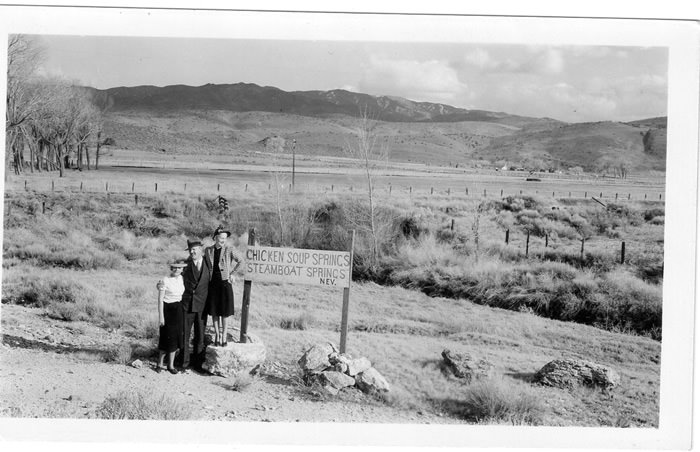edble traditions
LETTING OFF STEAM
Seeking wellness in days past at Steamboat Hot Springs.
WRITTEN BY SHARON HONIG-BEAR
Steamboat Hot Springs colored postcard courtesy of Special Collections at the University of Nevada, Reno
When you think of famous hot spring resorts, you think Baden-Baden in Germany, Bath in England, or Vichy in France. In its time, Steamboat Hot Springs, located 11 miles south of Downtown Reno, would have been listed among them. Early settlers, famous visitors, and even a famous horse came to the thermal springs to “take the waters,” as they used to say, in order to cure many ills and improve their overall wellness.
A welcome stop
What a sight the springs were. Before 1900, the Steamboat area featured the third-largest geyser in the U.S., erupting 60 to 80 feet into the air, surrounded by open pools of boiling water. Native Americans often located their winter camps there. Emigrants coming through the Truckee Meadows in the mid-1800s used the springs for cooking and bathing.
Mark Twain publicized the Steamboat name in 1863 when he wrote, “From one spring the boiling water is ejected a foot or more by the infernal force at work below, and in the vicinity of all of them one can hear a constant rumbling and surging, somewhat resembling the noises peculiar to a steamboat in motion — hence the name.”
One hot spring became especially famous and was described with appetizing language in 1879 in the Nevada State Journal: “Among the springs … is one that when salt and pepper are added to its waters, tastes so near like chicken soup that it will deceive anyone. In fact some go so far as to say it out-chickens the genuine article.”
Renamed Chicken Soup Hot Springs, the spring’s water was analyzed in the 1880s and found to contain natural chlorine, sodium, silica, borate, sulfate, carbonate, potassium, lithium, calcium, arsenic, phosphate, antimony, magnesium, alumina, iron, and mercury. Not exactly your mother’s chicken soup!

Chicken Soup Hot Springs photo courtesy of Western Nevada Historic Photo Collection
The Saratoga of Nevada
Whatever the water’s taste, the remote area was a magnet for visitors seeking promised cures for blood disorders, rheumatism, or nervous imbalance. By 1859-60, sheds were constructed to capture the steam and artesian spring water. It was Dr. James Ellis, a hydrotherapist from England, who created buzz about the springs when he established a hospital on the premises in 1861. The timing was perfect since the nearby silver mines of the Comstock Lode brought both traffic and renown. Volume further increased when the Virginia & Truckee Railroad finally reached Steamboat in 1871, making it only a half-hour ride from Downtown Reno. The Grand Hotel, a dance hall, and a saloon were added. President Ulysses S. Grant and his family visited in 1879. Author John Townley dubbed Steamboat “The Saratoga of Nevada.”
In the 1920s and ’30s, the area’s fame attracted the sports world. In 1931-32, Paulino Uzcudun, a Basque heavyweight boxer, and King Levinsky, a Chicago heavyweight, trained here with Jack Dempsey while preparing for 20-round bouts with Max Baer. Horses also used the springs, and champion Man o’ War arrived in the 1940s after sustaining serious injuries. Were the waters magic? The horse returned to win the Kentucky Derby, despite many thinking he would never race again.
Natural calamities
Nature often intervened in developments at the springs. On Dec. 10, 1900, an earthquake caused the hot springs and geyser to dry up. A year later, a wildfire burned the hotel and most of the other buildings. In 1925, Dr. Edna Carver bought the land, drilled a new well, and built the Pioneer State Health Hotel. Nature again triumphed with another devastating fire in 1937. Facilities were rebuilt, only to be burned again in 1942. Carver envisioned a major resort at Steamboat Springs. Noted architect Paul Revere Williams, who designed the Lear Theater and the Herman House at Rancho San Rafael in Reno and was widely known as architect to the stars, even created a master design for the resort. It was never built.
On a cold day, you still can see steam rising from the hills near Steamboat. Ormat Technologies Inc. harnesses some for its geothermal power plant. But tucked in the creases of earth east of U.S. Hwy. 395 Alternate, visitors still can take the waters at the Steamboat Hot Springs Healing Center and Spa, which connects visitors not only to the explosive earth but also to a little bit of extraordinary Nevada history.
Sharon Honig-Bear was the longtime restaurant writer for the Reno Gazette-Journal. She is a tour leader with Historic Reno Preservation Society and founder of the annual Reno Harvest of Homes Tour.


